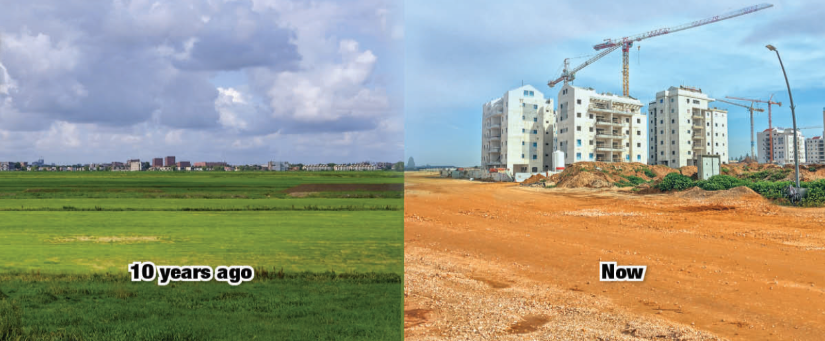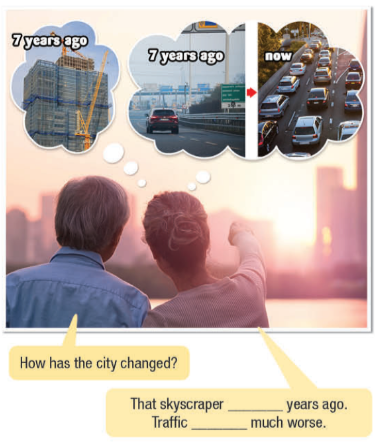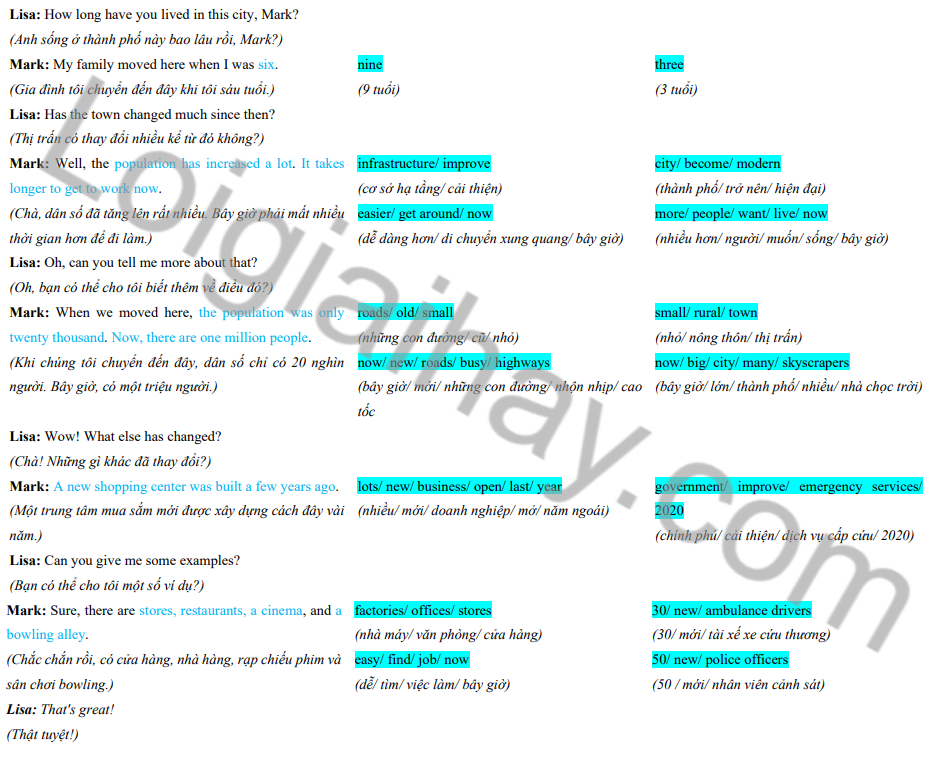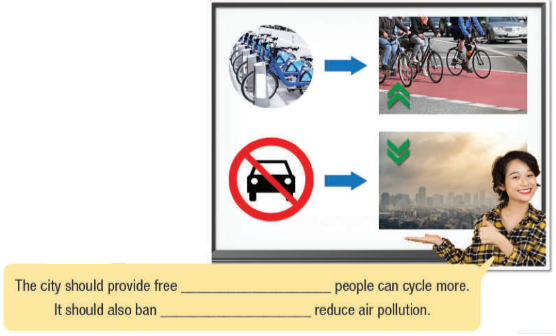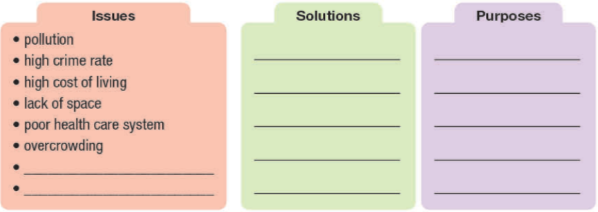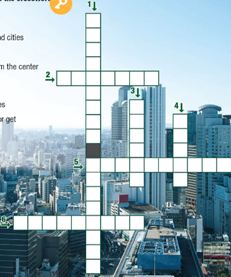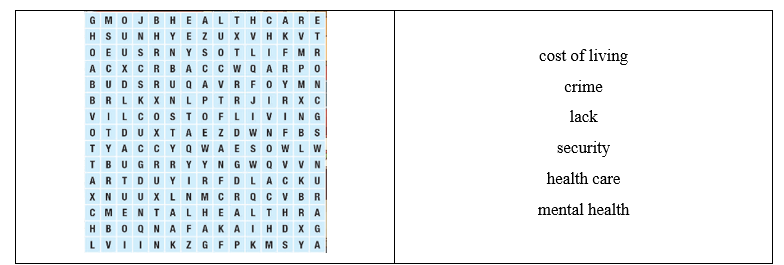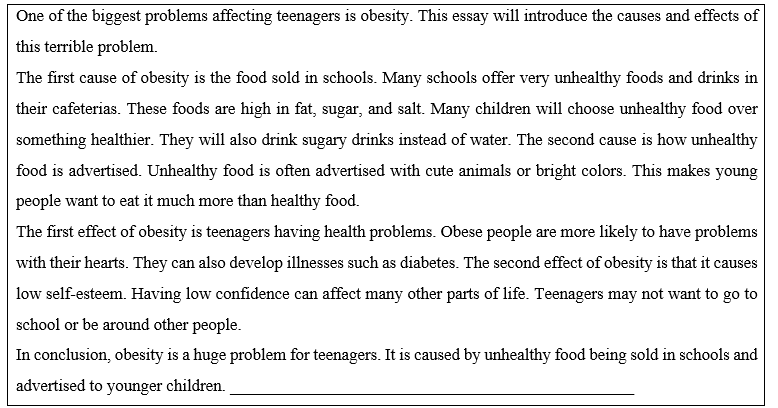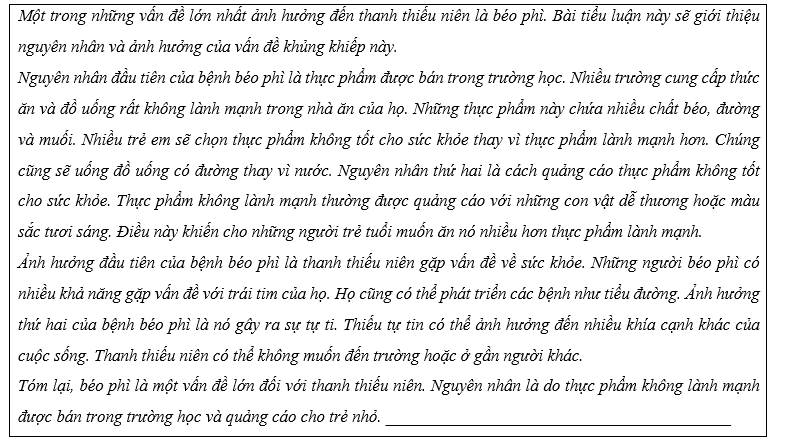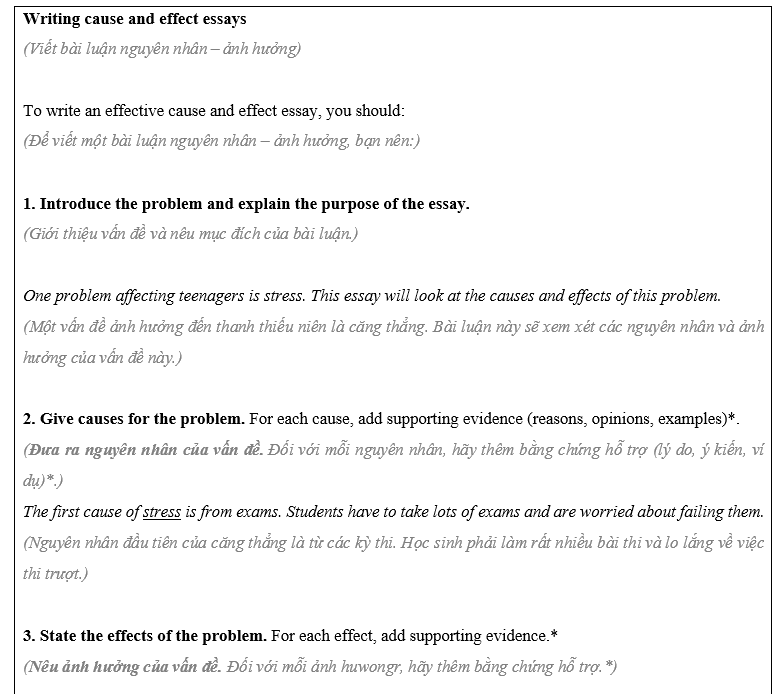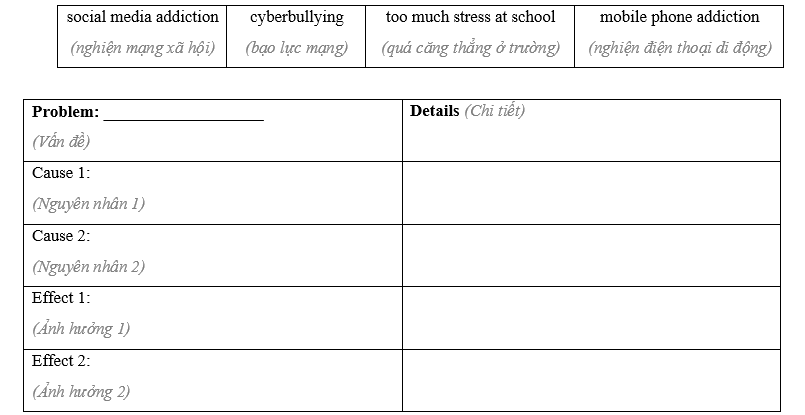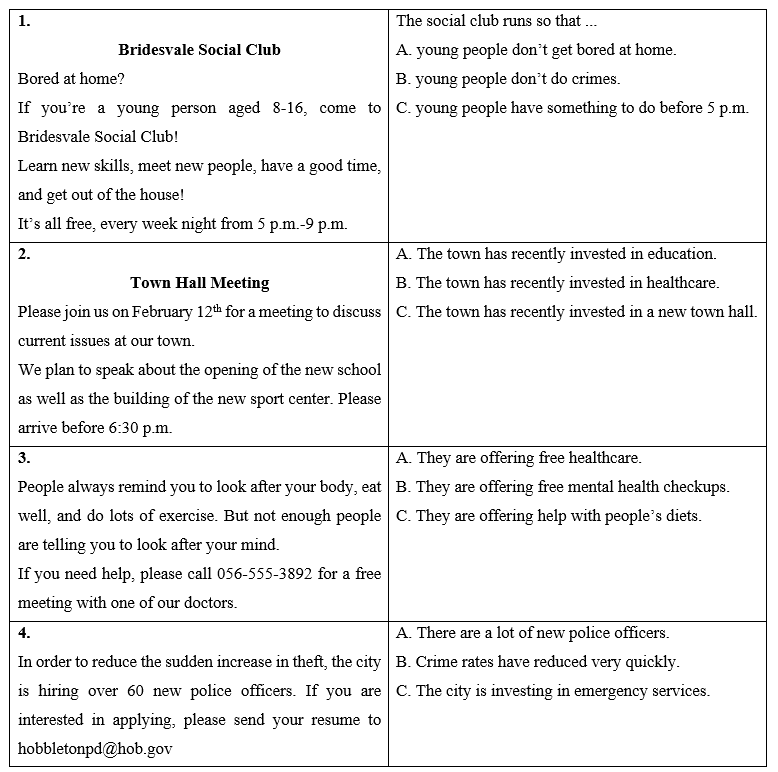Giải SGK, SBT Unit 3. Social Issues iLearn Smart World
Giải SGK, SBT Unit 3 iLearn Smart World
a. Match the underlined words with the definitions. Listen and repeat.
(Nối các từ được gạch chân với các định nghĩa. Lắng nghe và lặp lại.)
|
1. b I used to live in a rural area. There were farms all around our house, and the nearest shopping mall was 30 kilometers away. 2. _____ A new skyscraper has been built. At 438 meters, it's the tallest building in the country. 3. _____ We live on the outskirts of the city. It takes us nearly an hour to get to the city center. 4. _____ The city needs a new highway. People need a faster way to get to the next town. 5. _____ The government needs to invest more money in public transportation. That way, people will use buses and the subway more. 6. _____ The city needs better emergency services. Crime is very high, and there aren't nearly enough ambulances or firefighters. |
a. a very tall building b. away from large towns and cities c. the parts of a town or city that are furthest from the center d. public organizations that help with emergencies e. spend money on something to make it better or get something in return f. a large street, often connecting large towns and cities |
c. Read the Conversation Skill box. Then, listen and repeat.
(Đọc hộp Kỹ năng giao tiếp. Sau đó, nghe và lặp lại.)
|
Conversation Skill (Kỹ năng giao tiếp) Asking for more detailed information (Yêu cầu thông tin chi tiết hơn) To ask for more detailed information, say: (Để hỏi thông tin chi tiết hơn, hãy nói) A: Could you give me an example? (Bạn có thể cho tôi một ví dụ?) B: Yes, sure.... (Vâng, chắc chắn rồi....) A: Can you tell me more about (why they were built)? (Bạn có thể cho tôi biết thêm về (tại sao chúng được xây dựng) không?) B: No problem. They're... (Không sao. Họ đang...) |
INTERVIEW: MY TOWN HAS CHANGED
(PHỎNG VẤN: THỊ TRẤN CỦA TÔI ĐÃ THAY ĐỔI)
a. You're doing a news report about small town developments. In pairs: Student A, you're a news reporter. Read your role card and interview Student B.
(Bạn đang làm một bản tin về sự phát triển của một thị trấn nhỏ. Theo cặp: Học sinh A, bạn là phóng viên tin tức. Đọc thẻ vai trò của bạn và phỏng vấn học sinh B.)
|
Reporter (Phóng viên) Find out about: (Tìm hiểu về) • Basic information about the person (name/age/ how long they have lived in Watford) (Thông tin cơ bản về người đó (tên/tuổi/họ đã sống bao lâu ở Watford)) • What Walford used to be like (Walford đã từng như thế nào) • How the town has changed: (Thị trấn đã thay đổi như thế nào) - Infrastructure (Cơ sở hạ tầng) - Housing and buildings (Nhà ở và công trình) - Anything else? (Còn gì nữa không?) • Whether getting jobs is easier (Có dễ xin việc hơn không) |
Student B, you live in Watford. Read your role card, complete the information below with your own ideas, and add some extra details. Answer Student A's questions.
(Học sinh B, bạn sống ở Watford. Đọc thẻ vai trò của bạn, hoàn thành thông tin bên dưới với ý tưởng của riêng bạn và thêm một số chi tiết bổ sung. Trả lời câu hỏi của học sinh A.)
You've lived in Watford for 12 years. It used to be a small town where many people lived in poverty. Many changes have happened:
(Bạn đã sống ở Watford được 12 năm. Nó từng là một thị trấn nhỏ nơi có nhiều người sống trong cảnh nghèo khó. Nhiều thay đổi đã xảy ra)
|
|
Changes (Những thay đổi) |
Extra details (Chi tiết bổ sung) |
|
Infrastructure (Cơ sở hạ tầng) |
• Invested in infrastructure (Đầu tư vào cơ sở hạ tầng) |
•New highway built (Cao tốc mới được xây) |
|
Housing and buildings (Nhà ở và công trình) |
• More affordable apartments built (Nhiều căn hộ giá cả phải chăng được xây) |
|
|
Others (Những cái khác) |
• New ___________ built • School rebuilt last year (Năm ngoái xây trường học) • __________ invested in emergency services |
|
|
Jobs (Việc làm) |
• _________ new businesses opened • Big factory opened (Nhà máy lớn được mở) |
|
Practice: Take turns asking and answering about problems of living in cities.
(Thực hành: Thay phiên nhau hỏi và trả lời về các vấn đề của cuộc sống ở các thành phố.)
What can we do in order to solve overcrowding?
(Chúng ta có thể làm gì để giải quyết tình trạng quá tải?)
We should create jobs in the country so that people won’t move to cities.
(Chúng ta nên tạo việc làm trong nước để mọi người không chuyển đến các thành phố.)
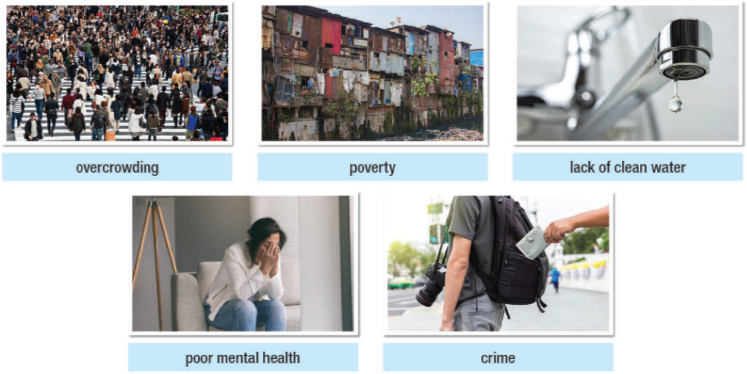
|
Solutions (Giải pháp) |
Purposes (Mục đích) |
|
create jobs in the country (tạo việc làm ở đất nước) |
people won’t move to cities (mọi người sẽ không chuyển đến thành phố) |
|
build more parks (xây thêm công viên) |
have more places to socialize (có thêm nơi giao lưu) |
|
help poor people find jobs (giúp người nghèo tìm việc làm) |
have money to support themselves (có tiền nuôi tự nuôi bản thân) |
|
free mental health help services (dịch vụ trợ giúp sức khỏe tâm thần miễn phí) |
people feel less stressed (mọi người cảm thấy bớt căng thẳng hơn) |
|
free social clubs and increase community activities (các câu lạc bộ xã hội miễn phí và tăng cường các hoạt động cộng đồng) |
save money and improve community relationships (tiết kiệm tiền và cải thiện các mối quan hệ cộng đồng) |
|
free health care and education for poor people (chăm sóc sức khỏe và giáo dục miễn phí cho người nghèo) |
get help when they need (giúp đỡ khi họ cần) |
|
more security cameras (thêm camera an ninh) |
prevent crime (ngăn ngừa tội phạm) |
|
invest in better water infrastructure (đầu tư vào cơ sở hạ tầng nước tốt hơn) |
not waste water (không lãng phí nước) |
b. Now, read and complete the notes that John used to plan his essay. Write ONE word only for each answer.
(Bây giờ, hãy đọc và hoàn thành các ghi chú mà John đã sử dụng để dàn dựng bài luận của mình. Chỉ viết MỘT từ cho mỗi câu trả lời.)
|
Problem: Social media addiction |
Details |
|
Cause 1: social media (1) __________ |
Designed to be addictive, know what you like, always have new content |
|
Cause 2: need to create "online life" |
Being (2) __________ and popular online is more important than offline |
|
Effect 1: low self-esteem = not feeling (3) ______ |
Sadness when seeing other people having fun |
|
Effect 2: damages “offline life” |
Too distracted => problems with (4) _______ and family |
a. Read about writing cause and effect essays. Then, read John's essay again and underline the two causes and two effects.
(Đọc về cách viết bài luận về nguyên nhân và kết quả. Sau đó, đọc lại bài luận của John và gạch dưới hai nguyên nhân và hai kết quả.)
|
Writing Skill (Kĩ năng viết) To write an effective cause and effect essay, you should: (Để viết một bài luận nhân quả hiệu quả, bạn nên) 1. Introduce the problem and explain the purpose of the essay. (Giới thiệu vấn đề và nêu mục đích của bài văn.) One problem affecting teenagers is stress. This essay will look at the causes and effects of this problem. (Một vấn đề ảnh hưởng đến thanh thiếu niên là căng thẳng. Bài tiểu luận này sẽ xem xét các nguyên nhân và ảnh hưởng của vấn đề này.) 2. Give causes for the problem. For each cause, add supporting evidence (reasons, opinions, examples).* (Đưa ra nguyên nhân của vấn đề. Đối với mỗi nguyên nhân, hãy thêm bằng chứng hỗ trợ (lý do, ý kiến, ví dụ).*) The first cause of stress is from exams. Studente have to take lots of exame and are worried about failing them. (Nguyên nhân đầu tiên của căng thẳng là từ các kỳ thi. Học sinh phải tham gia rất nhiều kỳ thi và lo lắng về việc trượt chúng.) 3. State the effects of the problem. For each effect, add supporting evidence.* (Nêu tác hại của vấn đề. Đối với mỗi hiệu ứng, hãy thêm bằng chứng hỗ trợ.*) The first effect of stress is it affects your sleep. Students cannot sleep because they cannot stop thinking about their schoolwork. (Ảnh hưởng đầu tiên của căng thẳng là nó ảnh hưởng đến giấc ngủ của bạn. Học sinh không thể ngủ vì họ không thể ngừng suy nghĩ về bài tập ở trường.) 4. Give a conclusion. Restate the problem and the causes and effects that you described. (Đưa ra kết luận. Trình bày lại vấn đề và nguyên nhân cũng như ảnh hưởng mà bạn đã mô tả.) In conclusion, stress is a problem for teens. It is caused by exams that result in sleeping problems. (Tóm lại, căng thẳng là một vấn đề đối với thanh thiếu niên. Nó được gây ra bởi các kỳ thi dẫn đến các vấn đề về giấc ngủ.) *see "Giving supporting evidence in body paragraphs" on page 23 (*xem phần "Đưa ra bằng chứng hỗ trợ trong các đoạn thân bài" ở trang 23) |
b. Match the causes to the effects.
(Nối các nguyên nhân với các ảnh hưởng.)
|
1. Some students get bullied because they dress or act differently to others. 2. Class sizes are large because the city's population grew quickly in the last ten years. 3. Teenagers who don't get enough exercise can become overweight. 4. Some teens leave school because they have to work to earn money for their families. |
a. They can suffer from health problems and struggle to breathe when climbing stairs. b. It can be difficult to teachers to manage and control so many students. c. They will find it hard to get a good job in the future without any qualifications. d. They might drop out of school because they are afraid of getting hurt. |
a. In pairs: Look at the problems affecting teenagers in Vietnam. What are the causes of these problems? What are the effects?
(Theo cặp: Nhìn vào những vấn đề ảnh hưởng đến thanh thiếu niên ở Việt Nam. Nguyên nhân của những vấn đề này là gì? Các ảnh hưởng là gì?)
|
obesity (béo phì) |
not finishing high school (không học hết phổ thông) |
bullying (bắt nạt) |
large class sizes (sĩ số lớp đông) |
Some students don’t finish high school because they get bored or fail too many exams.
(Một số học sinh không học xong trung học vì chán nản hoặc trượt quá nhiều kỳ thi.)
What are the effects of not finishing school?
(Những ảnh hưởng của việc không học xong là gì?)
It's harder to find a good job and make enough money.
(Thật khó để tìm được một công việc tốt và kiếm đủ tiền.)
b. Choose a problem, then think of two causes and effects and fill in the table. Add details to explain each cause and effect.
(Chọn một vấn đề, sau đó nghĩ đến hai nguyên nhân và kết quả và điền vào bảng. Thêm chi tiết để giải thích từng nguyên nhân và kết quả.)
|
Problem: ____________________ |
Details |
|
Cause 1: |
|
|
Cause 2: |
|
|
Effect 1: |
|
|
Effect 2: |
|


